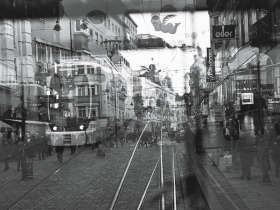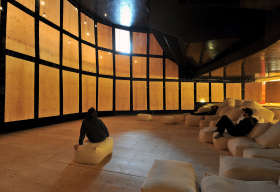Hörstadt / Acoustic City

Copyright: Pondell
Our acoustic environment is a concrete manifestation of our living conditions. Sound affects us directly and unavoidably—after all, we can’t turn off our hearing. Nevertheless, society’s acoustic awareness is severely underdeveloped. And architects and traffic & urban planners have turned a deaf ear to people’s concerns. Technical revolutions have brought forth all-encompassing noise pollution and brought about the commercialization of hearing. Products ranging from cars to cookies are acoustically designed to accentuate their quality. Advertising counters visual stimulus overload by raining down audible messages on consumers. Stores, shopping malls, restaurants, waiting rooms, telephone on-hold loops and even public toilets are the scenes of the inescapable musical bombardment of millions of people. All this happens in a legal vacuum beyond the fringe of noise abatement legislation highly limited in its purview. We live in the Wild West of hearing, a lawless land where there is practically no binding regulation of our acoustic coexistence in a democratic society. ACOUSTIC CITY took the concept of Linz’s legendary Klangwolke (Cloud of Sound) to the next level, and developed unprecedented ways for the city to unfold its extraordinary potential in this area. Politics, business, culture, art, education and tourism must declare the human being to be a holistic entity, an acoustic being, the center of considerations, the measure of all things. We must listen to what’s beyond fashion and transient technologies.
ACOUSTIC CITY is an initiative seeking to achieve an audible environment intentionally designed to be fit for human beings. It consists of a campaign to STAMP OUT ACOUSTIC POLLUTION, the Linzer Charta that established guidelines for urban acoustic planning, and the Akustikon, a space in downtown Linz dedicated to hearing-related phenomena. The ACOUSTIC CITY agenda has the support of numerous individuals and institutions active in social and cultural life.
WAS // Conscious hearing
WHEN // Since 2007
WHERE // In Linz and various partner cities
www.hoerstadt.at
PARTICIPIANTS //

Ruhepol Centralkino / Acoustic Refuge Centralkino

Copyright: Linz09
Ruhepol Centralkino was based on an idea by Viennese urban researcher and acoustician Peter Payer, whose concept was, in turn, inspired by an early 20th-century precursor. Almost 100 years ago, Dresden physician R. Sommer set up a public hall of silence that was a very popular feature among visitors to the Hygiene Exhibition there.
The aim of this historical model of a publicly accessible acoustic refuge was above all to have a calming effect upon citydwellers who had been made “nervous,” edgy and irritable by their increasingly noisy surroundings and the acceleration of everyday life. Thus, a major part of Acoustic City’s mission was to establish a space amidst the cityscape that was free of noise pollution and that enabled people to experience the elementary auditory phenomenon of silence in a non-religious setting. The 28,000 visitors to this facility attested to the need for and interest in an acoustic refuge.
The venue has had an eventful past. Landstraße 36 was once the address of Hotel Schiff, the scene of bloody skirmishes between the forces of the Austro-fascist regime and republican resistance fighters during the Austrian Civil War in February 1934. Later, the building complex housed the Social Democratic Party’s local headquarters and Centralkino, a mecca for generations of Linz cinéastes and a bastion that defied the extinction of downtown movie theaters into the 21st century. The actual acoustic refuge was located in the former screening room. The exits to the lobby along the side walls were closed off; the loge section of the original layout was reactivated and used as an access level. Both of the round spaces in the rear corners of the building were coated with warm-colored, brightly-lit soundproofing (convoluted) foam. They thus served as both attractive transitional zones and buffers between the lobby and the acoustic refuge. The ‘80s lobby furnishings left over from the movie-house days were removed. The underlying structures—some original fittings going back to 1909—were brought to light and given a coat of reed-green paint. A lighter-colored drapery cocoon partitioned off a space within a space amidst this raw substance refined with color. Here, at small tables, guests could drink tea, converse or read. Inside the main hall, wood was the sensorially soothing main design element. A loosely-woven tissue of plywood sheets was draped over the structural walls. A window shaft situated high up the wall let a concentrated ray of daylight stream in. With a height difference of about one meter to the loge level, the floor became a landscape of wood featuring steps and inward-sloping multi-level terraces on which groupings of beanbag chairs offered the possibility of sitting, reclining and listening to the sound of the space.
In November 2009, the CENTRALKINO ACOUSTIC REFUGE served as a place for mourning in conjunction with FESTIVAL 4020 GOD. In the public-yet-secluded and secular ambience of this space, mourners could avail themselves of the services of experienced grief counselors.
WHAT // Acoustic Refuge
WHERE // Ruhepol Centralkino: Landstrasse 36, 4020 Linz
WHEN // November 29, 2008-November 21, 2009
Ruhepol Centralkino
back





